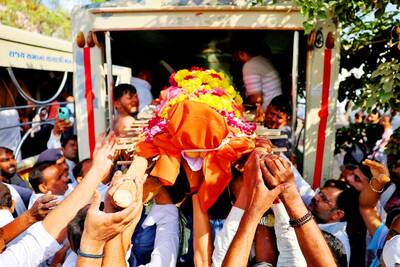Archeology students learning how to use mapping equipment have stumbled across the site of large Roman buildings on the banks of the river Usk in Wales, right by one of the best-known and most-studied Roman sites in Britain.
The structures have yet to be excavated, but one is enormous, possibly a granary or warehouse — or a palatial riverside villa.
The students located the previously unknown buildings as they were learning to use geophysical tools which can reveal the outlines of buried structures, in fields by the Roman fortress at Caerleon — claimed by some romantics as King Arthur’s Camelot. The area has been excavated and studied for two centuries.
The buildings lie outside the fortress walls, where archeologists believed there was nothing except a few outbuildings and stores.
Cardiff University, whose students of the school of history, archeology and religion made the discovery, has created a fly-through animation, which contrary to the old guidebooks and maps, now shows buildings stuffed in between the fortress and the river, including a huge rectangular complex surrounding a courtyard the size of a parade ground.
Pete Guest, senior lecturer in Roman archeology at the university, described the discovery as “completely new and totally unexpected.”
“It is difficult to be certain about what we have found because nothing like this has been discovered in Roman Britain before. The buildings’ ground plans suggest that they were of some importance. We think that they could have included markets, administrative buildings, such as town halls, bathhouses, store buildings or even possibly temples,” Guest said.
“The biggest is enormous and must be one of the largest buildings known from Roman Britain. We can only guess what it was for, but at the moment we’re working on the idea that it had something to do with a harbor on the river, although it does look uncannily like a residential villa building — if that’s the case it was built on a palatial scale,” he said.
Caerleon in Wales, and Chester and York both in the north of England, are the only three known permanent legionary forts, but the others are much harder to excavate because most of the remains are buried under the modern cities.
In Caerleon, almost the entire site is still in open ground, though many of the 17th and 18th century buildings incorporated stones borrowed from the Romans.
More answers may emerge in the next weeks, as the students join staff and a team from University College London in a six-week dig.
The dig, which will continue until the middle of next month, will be open to the public with daily tours and displays of finds. The excavation will be updated regularly at the Council for British Archaeology’s Web site.

POLITICAL PRISONERS VS DEPORTEES: Venezuela’s prosecutor’s office slammed the call by El Salvador’s leader, accusing him of crimes against humanity Salvadoran President Nayib Bukele on Sunday proposed carrying out a prisoner swap with Venezuela, suggesting he would exchange Venezuelan deportees from the US his government has kept imprisoned for what he called “political prisoners” in Venezuela. In a post on X, directed at Venezuelan President Nicolas Maduro, Bukele listed off a number of family members of high-level opposition figures in Venezuela, journalists and activists detained during the South American government’s electoral crackdown last year. “The only reason they are imprisoned is for having opposed you and your electoral fraud,” he wrote to Maduro. “However, I want to propose a humanitarian agreement that

ECONOMIC WORRIES: The ruling PAP faces voters amid concerns that the city-state faces the possibility of a recession and job losses amid Washington’s tariffs Singapore yesterday finalized contestants for its general election on Saturday next week, with the ruling People’s Action Party (PAP) fielding 32 new candidates in the biggest refresh of the party that has ruled the city-state since independence in 1965. The move follows a pledge by Singaporean Prime Minister Lawrence Wong (黃循財), who took office last year and assumed the PAP leadership, to “bring in new blood, new ideas and new energy” to steer the country of 6 million people. His latest shake-up beats that of predecessors Lee Hsien Loong (李顯龍) and Goh Chok Tong (吳作棟), who replaced 24 and 11 politicians respectively

Young women standing idly around a park in Tokyo’s west suggest that a giant statue of Godzilla is not the only attraction for a record number of foreign tourists. Their faces lit by the cold glow of their phones, the women lining Okubo Park are evidence that sex tourism has developed as a dark flipside to the bustling Kabukicho nightlife district. Increasing numbers of foreign men are flocking to the area after seeing videos on social media. One of the women said that the area near Kabukicho, where Godzilla rumbles and belches smoke atop a cinema, has become a “real

‘WATER WARFARE’: A Pakistani official called India’s suspension of a 65-year-old treaty on the sharing of waters from the Indus River ‘a cowardly, illegal move’ Pakistan yesterday canceled visas for Indian nationals, closed its airspace for all Indian-owned or operated airlines, and suspended all trade with India, including to and from any third country. The retaliatory measures follow India’s decision to suspend visas for Pakistani nationals in the aftermath of a deadly attack by shooters in Kashmir that killed 26 people, mostly tourists. The rare attack on civilians shocked and outraged India and prompted calls for action against their country’s archenemy, Pakistan. New Delhi did not publicly produce evidence connecting the attack to its neighbor, but said it had “cross-border” links to Pakistan. Pakistan denied any connection to